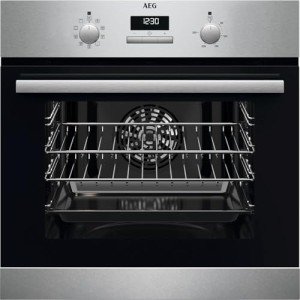
Best Single Oven Electric
إضافة إلى استعراض اتبعنظرة عامة
-
تأسست تاريخ يوليو 3, 1946
-
القطاعات قانون
-
نشر الوظائف 0
-
ينظر 10
وصف الشركة
Five Killer Quora Answers On Single Fan Oven
Understanding the Single Fan Oven: A Comprehensive Guide
The culinary world has evolved considerably throughout the years, with appliances becoming more sophisticated and effective. One such advancement is the single fan oven, a kitchen staple for many home cooks and expert chefs alike. This article looks into the complexities of single fan ovens, their benefits, and useful pointers for usage.
What is a Single Fan Oven?
A single fan oven, likewise known as a stove, is developed to prepare food evenly utilizing a fan and an internal exhaust system. Unlike standard ovens that rely primarily on convected heat, single fan ovens circulate hot air around the food, ensuring a consistent temperature throughout the cooking process. This feature improves cooking efficiency and reduces cooking times compared to standard ovens.
How Does a Single Fan Oven Work?
The mechanics of a single fan oven are simple however ingenious. The oven makes up several essential elements:
- Heating Element: This creates the heat needed for cooking, usually situated at the top and bottom of the oven.
- Fan: Positioned at the back of the oven, this part circulates the hot air around the food.
- Control board: It allows users to set the temperature level and cooking time.
- Thermostat: This device displays and keeps the preferred temperature throughout cooking.
When the oven is switched on, the heating aspects warm up, and the fan starts to flow the heat uniformly. This guarantees that all sides of the food are exposed to hot air, resulting in much better cooking outcomes– particularly for baked goods.
Advantages of Using a Single Fan Oven
Single fan ovens boast several benefits, making them popular among cooking lovers. The primary benefits consist of:
1. Even Cooking
- The flowing air prevents cold and hot areas within the oven, allowing food to cook equally. This is especially beneficial for baking pastries, cakes, and bread.
2. Decreased Cooking Time
- By distributing hot air, stove typically prepare food faster than conventional ovens. This can cause time cost savings in meal preparation.
3. Energy Efficiency
- Single fan ovens generally use less energy, as they can prepare food quicker and may need lower temperature levels.
4. Browning and Crisping
- The airflow in a single fan oven helps accomplish a preferable golden-brown surface on meals, particularly casseroles, roasted vegetables, and meats.
5. Versatility
- These ovens are capable of a range of cooking designs, from roasting and baking to broiling and reheating leftovers.
Comparing Single Fan Ovens with Traditional Ovens
To much better comprehend the distinct qualities of a single fan oven, it’s helpful to compare it to a standard oven. The table listed below sums up essential differences:
| Feature | Single Fan Oven | Traditional Oven |
|---|---|---|
| Cooking Method | Convection (distributing air) | Radiant heat |
| Cooking Time | Shorter | Longer |
| Temperature Consistency | More constant | Can have hot/cold areas |
| Energy Consumption | Normally lower | Higher |
| Suitable for Baking | Better browning and increasing | Excellent for roasting |
How to Use a Single Fan Oven
For ideal outcomes with a single fan oven, consider these useful suggestions:
-
Adjust Temperature and Cooking Time:
- When using a single fan oven, lower the cooking temperature level by about 20 ° F (10 ° C) compared to standard recipes. As a rule of thumb, check for doneness a bit earlier than mentioned.
-
Use Shallow Baking Pans:
- Shallow pans allow better air flow, promoting even cooking and browning.
-
Avoid Crowding the Oven:
- Ensure sufficient area between meals for air flow.
-
Turn Baking Sheets:
- For multiple trays or pans, turn them halfway through cooking to ensure even heat circulation.
-
Keep the Oven Door Closed:
- Each time the door is opened, heat escapes; prevent unnecessary openings throughout cooking.
Frequently Asked Questions About Single Fan Ovens
-
Can I use routine recipes in a single fan oven?
- Yes, but it’s advised to adjust both the temperature and cooking time for optimal outcomes.
-
Are single fan ovens more expensive than traditional ovens?
- They can vary in price, however while some models may be more pricey, their efficiency can cause cost savings on energy expenses.
-
Can I bake numerous items at the same time?
- Yes, however spaced out correctly for even air circulation. It’s recommended to turn trays midway through cooking.
-
Do single fan ovens come with extra functions?
- Many models feature self-cleaning alternatives, several cooking modes, and clever technology for boosted benefit.
-
Is upkeep different for single fan ovens?
- Maintenance is comparable but be mindful of the fan and ensure it’s kept clean for optimal performance.
The single fan oven sticks out as a superior choice for those wanting to boost their culinary skills and efficiency in the kitchen. Its ability to prepare food evenly and quicker can change the cooking experience, making even the most complicated recipes easy to execute. By comprehending how to use a single fan oven successfully and leveraging its benefits, home cooks and professional chefs can enjoy a more enjoyable and productive cooking journey.

